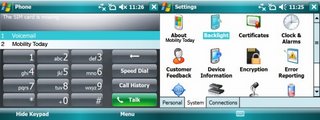...or "Why would I want a watered-down hack of an Operating System?"I hear alot of people complain that Windows Mobile "Smartphone Edition" is not the real Windows Mobile that you'd find on a Pocket PC. This has created a lot of angry consumers who feel that they are tricked when they buy new devices such as the Motorola Q, HTC Tornado (T-mobile SDA, Cingular 2125), and the T-mobile DASH, which are all advertised as being Windows Mobile, yet are missing the telltale signs of a PDA such as a
touchscreen and common
office applications.
Some of these critics claim that this can not be considered Windows Mobile at all, and that it is an inferior product that bears name recognition.
These people are very misinformed.The first thing I'd like to point out is that the "Smartphone Edition" of Windows Mobile is not just closely related to the Pocket PC edition, but they are in actuality one and the same thing: A PDA-tailored port of the Windows CE 5 OS .
What many people don't understand is that Windows CE is designed to be a completely adaptable modular operating system, not just for PDAs, so that all sorts of devices can run the same software. The plan was that everything from
Digital Cameras to
Car Stereos to
Video Game systems would all run Windows CE, and common applications could be easily developed for them all.
In fact, one of the motives for the original Windows CE was for television set-top boxes (similiar to the web-tv concept that never caught on), and if anyone recalls the
Sega Dreamcast game console system, it shipped with a version of Windows CE built-in so that you could manage saved game files, use it to browse the web, play Windows Media, ...even write your own software and games for it.
I've even seen the popular Windows Mobile divx player TCMP actually being used in a Dreamcast to display a divx movie on a TV screen!So, if they're all Windows CE, what does the name Windows Mobile mean?
This is a difficult question to answer since some people make the mistake of using the two names interchangeably.
Since Win CE can adapt and appear in so many different forms, Microsoft started giving the custom tailored incarnations of it their own names. The most popular incarnation was the one that they gave a PDA-oriented interface to, including modules such as full duplex sound, connectivity, synchronization, icon-driven GUI, and touch-screen support. They called this version "
Pocket PC", since it was designed for portable computing needs. Then, around 2003, it became apparent that the PDA comes in various forms, from tablets to handhelds to cellular phones, and the term Pocket PC could be deemed too device specific for a PDA-oriented OS. So, it was renamed to "
Windows Mobile 2003", which has a few spin-off versions that support various forms of input interface including touch screen, t9 keypad, joystick, and keyboard.
However, the major difference between the Windows Mobile versions stops after the display and input differences. Under the hood, its all the same thing. This means that software written for Pocket PC Edition will actually run if copied over to the Smartphone Edition!
The problems arise when the developer assumes that someone is using a Pocket PC with a touchscreen, for example an application that requires you to tap portions of the screen. This is very frustrating if you can not actually tap anything!
There are work-arounds, but that's not the point of this entry. I'll get to that another time.
The point here is to illustrate that
the Smartphone Edition of Windows Mobile is not "inferior" in any way to the PPC version. It only seems that way because it is marketed differently, for example Microsoft left out included versions of Word and Excel. The reason for this has been said to be because of the numeric keypad entry, claiming that "these devices are better for reading data than entering it". Therefore, many smartphones come with simple document reading software that will easily open Word, Excel and even powerpoint and Adobe PDF documents, but not edit them.
If you want to enter data on your T9 keypad (like I do), there are 3rd party applications available for spreadsheets and word processing. But I understand why MS left them out... most people wouldn't use them.
Some say that it may also be some sort of marketing reason... if the smartphone had office support, and clearly did all the same things, they wouldn't be able to charge so much more for a Pocket PC phone.
Whatever the case may be, this smartphone user has not been fooled by the first impression, and I am now very happy with my non-Pocket PC device!


 No more 3rd party applications needed to do what a Pocket PC does out of the box!!
No more 3rd party applications needed to do what a Pocket PC does out of the box!!


